“I have a British background and I have always had tea and something sweet. First time I tried this clotted cream I almost ate the entire jar by itself, it is that good!” ~Kim

If you’ve never had a classic English afternoon tea with scones and clotted cream, you’re missing out!
Last week I was treated by the historic Biltmore Hotel in downtown Los Angeles to their classic English afternoon tea. If you’ve never had a classic afternoon tea, you need to experience it. The highlight of any afternoon tea, besides the tea, is the array of tiny treats that comes with it, and I always zero right in on the scones and clotted cream. (That’s them on level two of our 3 tiered tea tray.)
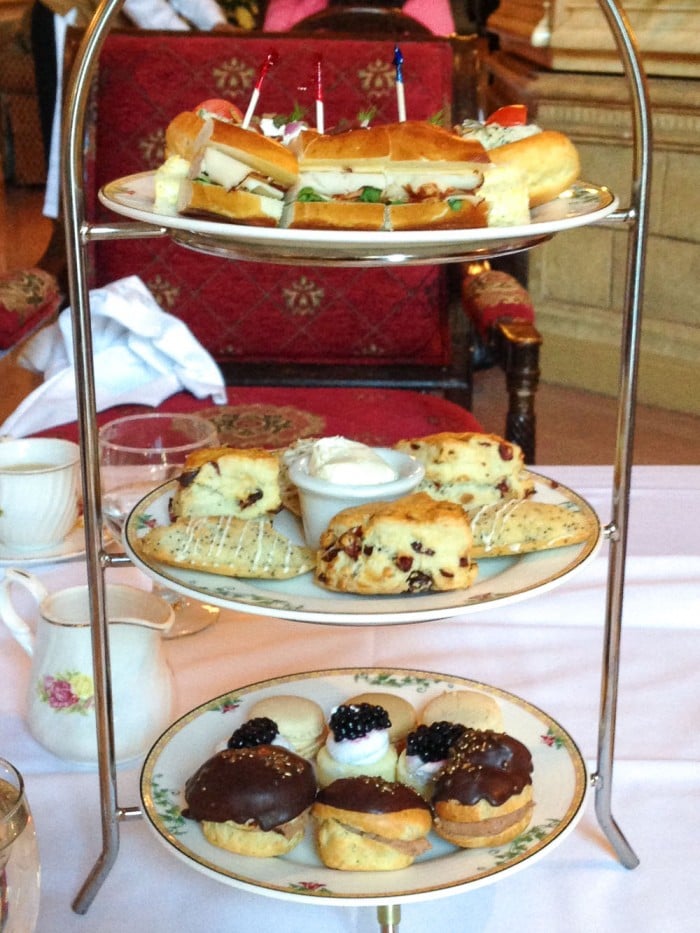
What is Clotted cream?
If you’ve never had it, clotted cream is a very thick rich spreadable form of heavy cream that was first invented ages ago by some very smart British farmers. Traditionally cream heated until it thickens and develops a slightly nutty flavor. Clotted cream has a high fat content (around 55-65%) and a dense texture. It’s not like whipped cream, or cream cheese, it’s not like butter…it has a unique decadent consistency and a wonderful soft flavor. It’s quite thick and spreadable, and when you slather it on a freshly baked scone there is no better thing in the world.
The little pot of clotted cream that we got at the Biltmore had me craving more, and happily I made the most astounding discovery…you can actually make clotted cream at home in your own kitchen. No more tracking it down in specialty stores and paying big bucks for the imported stuff. My homemade clotted cream was actually way better (and a whole lot fresher) than the British stuff I usually buy.

What does clotted cream taste like?
Clotted cream has a rich, creamy taste with a slightly nutty ‘cooked’ flavor. It’s luxurious and indulgent, with a dense, velvety texture that is thicker and creamier than regular whipped cream. Clotted cream is also slightly sweet, but not as sweet as whipped cream or frosting, with a delicate flavor that pairs well with desserts, fruit, and scones. The crust on top of the clotted cream adds a slightly caramelized and nutty flavor, which many people find particularly delicious. The mouthfeel of clotted cream is a key part of its charm, and is like nothing else you’ve ever had!
what you’ll need
- heavy or whipping cream that has not been ultra-pasteurized
- This is cream that has been pasteurized, but not ultra-pasteurized. Ultra-pasteurized cream is cream that has been heated to a higher temperature than regular pasteurized cream to extend its shelf life.

How to make clotted cream
This is an amazing process, I hardly had to do anything, and I end up with a ton of the richest, silkiest clotted cream I’ve ever had.
- I used 2 pints of (non-ultra-pasteurized) heavy cream.
- I poured them into a baking dish, and left it overnight in a 180F oven (the lowest my oven will go.)
- In the morning I let it cool and then refrigerated it for the rest of the day.
- Then I scooped it into jars, which was a little sloppy at first, and put them back in the refrigerator. Any little bit of liquid gets absorbed right into the clotted cream after you put it in the jars, and by the next morning when I had it with my scones, it was absolutely to die for.
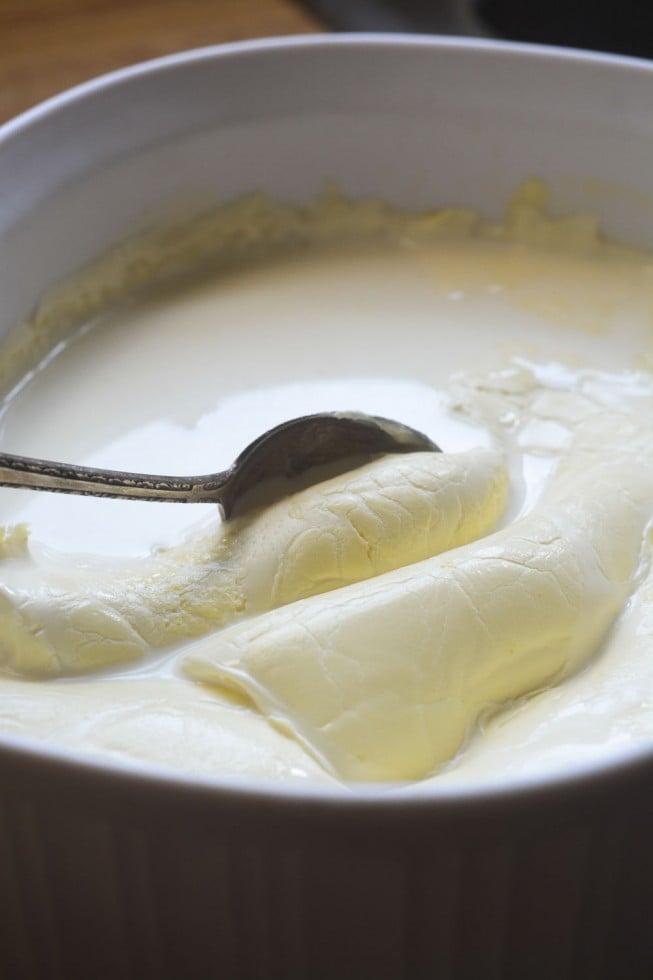
How long does clotted cream last?
Homemade clotted cream can last for up to 3-4 days when stored properly in the refrigerator. To extend its shelf life, it’s important to keep it in an airtight container and store it in the coldest part of the refrigerator, such as the back of the bottom shelf.
It’s important to note that clotted cream does not have any preservatives, so it should be consumed as soon as possible for the best flavor and texture. If you notice any changes in color, texture, or odor, discard the clotted cream immediately as it may have spoiled.
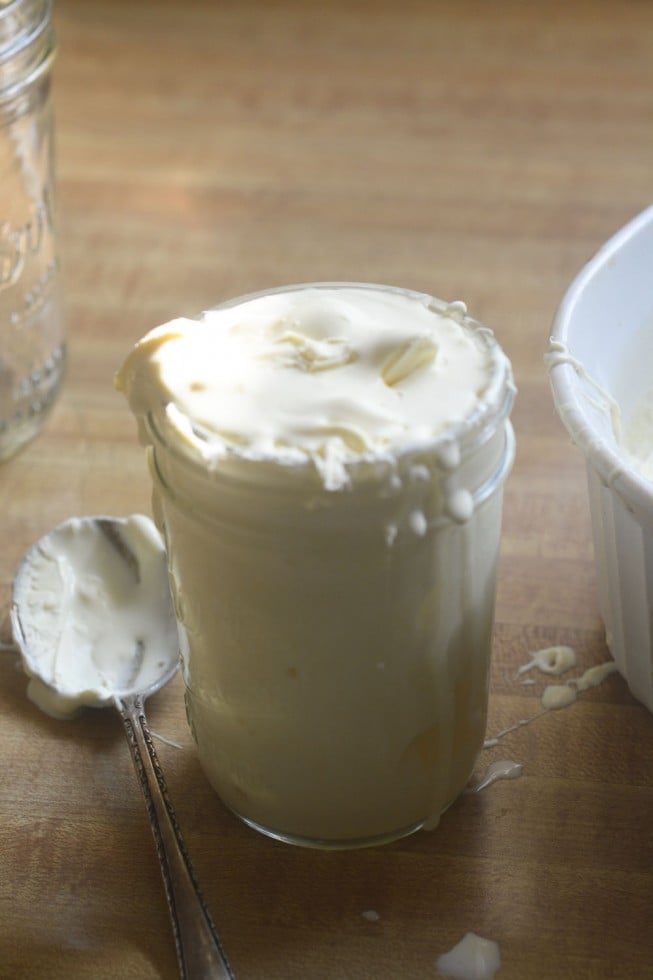
What to do with the leftover whey from making clotted cream
The leftover whey from making clotted cream can be used in a variety of ways:
- Adding it to smoothies or protein shakes for a boost of protein and nutrients.
- Using it as a substitute for milk or water in baking recipes such as bread, muffins, and pancakes.
- Using it as a marinade for meat or fish to tenderize and add flavor.
- Adding it to soups or stews for added richness and flavor.
- Using it as a liquid base for making homemade ricotta cheese or other soft cheeses.
- Feeding it to pets, as it is a good source of protein and nutrients for animals.
Note: It’s important to keep in mind that the leftover whey should be used or stored promptly to avoid spoilage. It can be stored in the refrigerator for up to a week or frozen for longer storage.
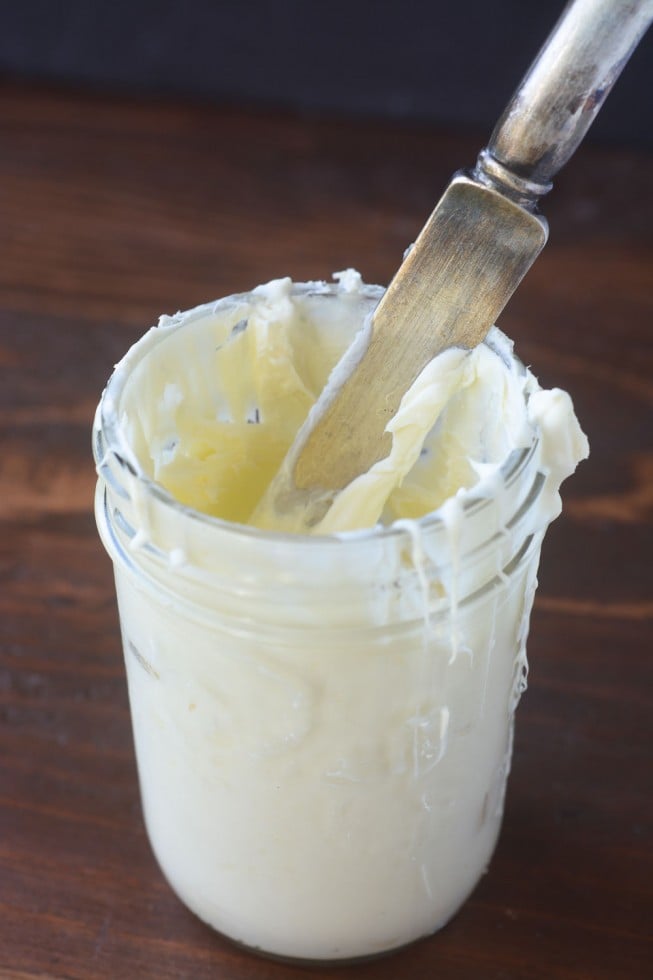
I can’t say enough good things about this project, the results far exceeded my expectations and it was absurdly easy. The only catch is that you can’t use ultra-pasteurized cream, which is cream that’s been processed for a longer shelf life. Many stores only sell ultra-pasteurized cream, so you have to search a bit for regular cream. I found mine at Whole Foods. Just read the labels… if it doesn’t say ultra-pasteurized on the label, you’re good to go.
can you make clotted cream with ultra-pasteurized cream?
Some readers in the comments below have had success with ultra-pasteurized cream. It is possible to make clotted cream from ultra-pasteurized cream, but it may be more difficult to achieve the desired texture and flavor. Ultra-pasteurization is a process that heats the cream to a higher temperature than regular pasteurization, which extends its shelf life but can also alter the proteins and enzymes in the cream. This can make it more difficult for the cream to form clots, which are necessary for making clotted cream.

What to eat with your homemade clotted cream
You will definitely want to make scones to go with your homemade clotted cream. I have lots of recipes for scones on the blog, but a simple one to start with is my Classic Cream Scones Recipe.
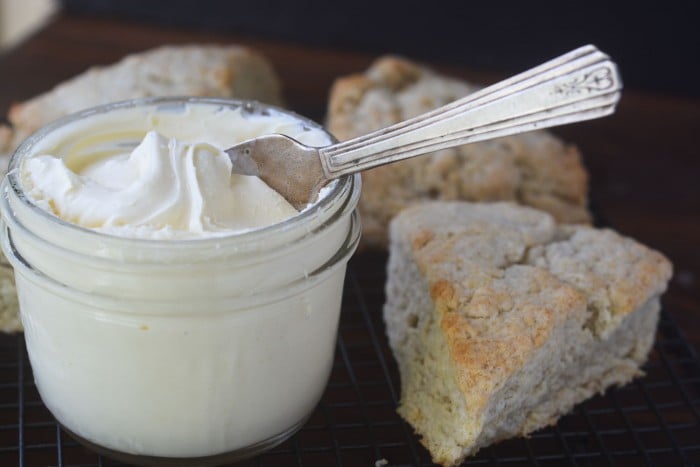
Tips for making clotted cream
- Make sure your cream is not ‘ultra pasteurized’, you will need to find regular pasteurized cream at a Whole Foods or other similar store. Ultra pasteurized cream has been treated in a way that prevents it from ‘clotting’.
- An oven thermometer is an essential kitchen tool, and really comes in handy for this project. If your oven is too cool or too hot your homemade clotted cream will not ‘clot’. Set your oven to 180F and then check the thermometer. You can adjust up or down as necessary.
- If your oven does not go down as low as 180F you can try one of my other methods for making clotted cream:

Homemade Clotted Cream
Video
Equipment
- a heavy casserole dish
Ingredients
- 2 pints heavy cream or whipping cream (double cream in the UK), avoid ultra-pasteurized cream for best results.
Instructions
- set your oven to 180F
- Pour the cream into the casserole dish. It should come up about 1-3 inches on the side.
- Set the dish, uncovered, in the oven and leave undisturbed for 12 hours. Be sure to leave the oven on the whole time. I do this overnight.
- Remove the dish from the oven and set to cool. Then cover and refrigerate. Note: the cream may seem thin at this point, but is going to thicken considerably overnight.
- The next morning scoop the thickened cream into a jar or jars, and cover and put back in the refrigerator. You can use the leftover cream for baking..
- Spread the clotted cream on freshly baked scones.
Nutrition























I’m curious to try this since I’ve never had clotted cream, but I have a gas oven. Do you think I could make it in a slow cooker?
Unfortunately most slow cookers are too hot, Agos, I think. Unless you have one where you can set an exact temperature, I’m not sure it will work. My oven is gas and it worked for me, but mine was able to be set at the proper low temperature.
Make sure container is sterilized in very hot
or boiling water B4 using. Bacteria can invite
off flavors. Never add sugar till after fridgerated
Hi Sue!
I was oh so excited to try out this recipe. I have a couple of questions though. I followed the recipe and left the baking dish in the oven for 12 hours at 180F. I took it out of the oven about an hour ago, and it is currently cooling on the stove top. My questions however are …. 1) Should I stir everything together in the dish before placing the dish in the refrigerator, or should I wait to stir all the contents together after the dish has sat in the fridge for a few hours , right before I place it in the jars? 3) Should I use a slotted spoon to put everything in the jars and just disregard what drips out of the spoon? Thank you for providing this recipe!
This worked beautifully. I used a generic pasteurized cream. I found it at Meijers. I poured it in my pan and put it in the oven one night and by morning I had a pale yellow skin on top. Very easy. It just took a few hours to get it to room temperature and a few more in the fridge for it to chill. By mid afternoon I was skimming it off the top and jarring it. I put some on top of zucchini bread I just baked and I have to admit that I wasn’t thrilled. It was missing something and I’m not sure if it’s salt or sugar. I’m making scones tomorrow morning and serving them up with my freezer strawberry jam and this beautiful clotted cream. I hope I like it better that way. Someone mentioned eating it on crackers so I might try it that way. Thanks for sharing this. I love trying new things. 🙂
Thanks for the step by step of your experience Laura, I know it will help others!
You do not want to disturb the cream when taking it out. Clotted cream typically has a yellow crust and it should remain on the top. You should cool for an least as long as you heat, and 24hr is better. When you heat the cream, clots form on the surface. The clots are then skimmed off the top. The cream can (and the authentic stuff does) have a golden yellow crust. If it is brown you have overheated the cream and it will be a mess. If you can’t get your oven down to a low enough temperature you can always use the scalding method: heating the shallow dish in a large pan of water. Place a ramekin on the base of a large pan to lift the dish from the direct heat of the stove, and fill the water up to about the same level as the cream in the dish. Do not let the cream boil, the water should be at a gentle simmer. Carefully top up the water when it gets low (I always use a jug with a lip because you risk pouring water into the cream dish instead of the water bath). After 12h (or as long as you dare to tend it) turn off the heat and allow everything to cool to room temperature. Carefully place in the fridge without disturbing the surface for 24h. You can then use a knife to poke a hole in the top and remove any excess liquid (the quality and thickness of the cream will determine how much liquid you have, in commercial production there tends to be very little). Clotted cream forms in fresh milk on its own. Here in CA you can get whole milk that isn’t homogenized with a “cream top”. That is the same as clotted cream. Commercially in the UK the cream has its fat content increased in a centrifuge before being placed in commercial scalding bath units. Using heavy whipping cream that is not ultra pasteurized in a home made scalding bath is about as close as you can get to the real thing without more commercial equipment and access to raw milk or cream.
This is amazing! Worked beautifully as written! You know you’re in trouble when this is good on crackers…no need to bake scones! Btw I used Promised Land heavy cream.
Thanks for the tip on the cream, and you know, I’ve never tried clotted cream on crackers, Melanie, that’s downright dangerous!!
I was wondering which brand to look for when getting the heavy cream so thank you for mentioning Promised Land. I know our store carries that brand. Now I’m anxious to try the recipe!
Hi, I just tried this recipe and just now put it in the jars. I was wondering thought, how much liquid I was supposed to have left over in the pan. Even with putting some in the jars with the firmer part I had a pint of liquid left over and got one pint of cream in the 2 half pint jars. I left it in my oven last night at 170 (lowest mine goes) for 12 hours. Cooled it for 2 hrs then covered an refrigerated another 12 hrs. I tried to everything you said even the not ultra pasteurized whipping cream. Is this the way it should have made up??
It varies fro batch to batch, Linda, and it sounds like you did everything right!
I am so disappointed. Just opened it and it’s gotten thinner not thicker over night. This one failed but my husband bought me enough cream for 3 more batches. I wonder if the dairy is ultra pasteurizing and labeling just pasteurized??? I won’t give up. Will let you know! Thanks
Oh what a bummer, Linda. This can be a tricky recipe, but once you hit on the exact method, you’ll be so glad. Could your oven have been slightly too cold?
I tried this recipe in my gas oven at 180 , and my cream turned brown and I had to throw it out
That’s such a shame Roxanne. All I can think is that maybe your oven runs hotter than it says it is, or maybe your container was very large and the cream was very shallow?
Mine turned out the same. I think you forgot to day to cover the dish while cooking.
I made this clotted cream last night and it turned out great! The only thing I did wrong was to cover the pan while heating in the oven,,,mis-read instructions! I don’t know if it made a difference or not. i will leave uncovered next time.
So glad it worked for you Laura!
Hello,
I’m planning on giving this recipe a try and I was wondering about the shelf-life of clotted cream? Should I plan to use it within a week or so, or does the baking process give it a longer shelf-life?
Cheers
It will last a fairly long time in the refrigerator, Lacey, up to a month…but it’s never lasted that long here!
my grandmother , a Cornish farmers wife made clotted cream every day in a saucepan at the back of the wood stove where it wasn’t too hot. …she would periodically skim off the ‘clots’ as they formed on top of the cream of the cream into a dish you’re right absolutely no sugar, this is VERY rich stuff on its own.it is important ,I think, to note that when it comes to adorning the scone with cream the jam comes first I prefer black currant or blackberry jam on the scone and top with as much clotted cream as you can stand …mmm, mmm,good
I love this, Norma, what a great memory ~ I can just see your grandmother scooping up the ‘clots’ 🙂 Blackberry jam is my favorite too.
my mum used to use channel island gold top milk and make this daily for the weekend tea, i have some steaming on the top of my cooker right now, it’s a long process but so worth the wait,
i am going to try the oven method to compare to two thanks for this recipe
Hi Mel,
Can you tell me how long/what approximate temp you use when doing this on the hob/stove top?
Many thanks!
Trying to make this as a surprise for Mother’s Day. I bought the correct cream, have it in a shallow dish, but not too shallow, and have left it in the oven for 12 hours at 175F which is my ovens warm setting. Checked on it this morning and I don’t see any skin on top it just looks like slightly thicker cream. My question is do I continue to leave it at 175 or turn my oven up to 200? Is 200 too high?
It sounds like maybe your oven’s ‘warm setting’ might have been too low, and even though it says it’s 175, it might actually be lower, if you check with a thermometer. I would probably turn it up a bit and leave it longer.
How did it turn out please ??
Just made this for a bridal shower tea and it turned out AMAZING!!! My daughters and I all thought it was the best clotted cream we’ve ever had-either in the UK or the USA. DELICIOUS! I substituted the leftover cream for the milk in our scone recipe and that worked out wonderfully as well. Thanks so much for sharing the recipe and the instructions, we’ll certainly make it again. 🙂
yay! I love ‘hearing’ the excitement in your voice! If you happen to come back and see my reply, can you let us know where you found your non-ultra-pasteurized cream? Some people are having trouble locating it.
We found the Kalona Super Natural organic whipping cream batch pasteurized at Whole Foods. I’ve got another batch in the oven now for a baby shower tea tomorrow. I hope it turns out just as delicious as the last one-yum!
Did it turn out as well as your first?
I think once you find a method and recipe…stick with it x
Just noticed your note above and thought I would let you know that I have made this several time (I have a batch in the fridge cooling now for a bridal shower tea tomorrow) and it has turned out great each time. Somewhere along the line I got a little cocky and thought I knew what I was doing enough to not come back and read the full instructions, and was separating the clotted cream from the cream straight out of the oven. This worked ok but the yield was down so I came back and re-read the instructions and remembered to cool in the fridge. Yield is back up and we are all happy to have clotted cream with our scones again. As some others have mentioned, sometimes a golden brown crust forms and I just whip it up with the rest of the clotted cream and it is fine. Thanks for sharing this recipe, I think it is the most used of all the ones I have saved! 🙂
I’m thrilled to hear this Donna, and good to know my instructions are spot on 🙂 You can never have too much clotted cream!
Thank you Sue. Like all of my baking adventures, there is always a learning curve. As EASY as this seemed, I seemed to of messed it up a bit. I swear I read the directions a hundred times ( okay I’m exaggerating but it was a lot and here is the mistake I made
1. My one batch ( good one) was in a wider width shallow round dish, the other one was deeper but shorter width
2. I kept the lids on ( don’t do that) I did remove the lids and kept it in the oven about 6 hrs longer
3 I disturbed the one that flopped ( I had to see if it clotted
Any way the one batch is in a glass dish in the fridge so we will see how it turns out in the morning.
I will definitely attempt this again since I went to the store to see that a jar of clotted cream (100mls) would cost me $ 8.00 ( yikes)
I know this does seem easy but it’s definitely a little fussy on the details…once you get it you’ll never turn back!! Good luck on the batch in the fridge 🙂